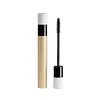Hermès Trait D’Hermès Revitalizing Care Mascara Versus Hourglass Cosmetics Unlocked Instant Extensions Mascara
What's inside
What's inside
 Key Ingredients
Key Ingredients

 Benefits
Benefits

 Concerns
Concerns

 Ingredients Side-by-side
Ingredients Side-by-side

Water
Skin ConditioningCandelilla Cera
EmollientButyrospermum Parkii Butter
Skin ConditioningPolyglyceryl-6 Distearate
EmulsifyingDimer Dilinoleyl Dimer Dilinoleate
EmollientGlycerin
HumectantCopernicia Cerifera Cera
EmollientMoringa Oil/Hydrogenated Moringa Oil Esters
Skin ConditioningPolyglyceryl-10 Myristate
Skin ConditioningPanicum Miliaceum Seed Extract
Skin ConditioningCetyl Alcohol
EmollientPhenoxyethanol
PreservativeXanthan Gum
EmulsifyingArginine
MaskingHelianthus Annuus Seed Oil
EmollientHydroxyacetophenone
AntioxidantPotassium Sorbate
PreservativeSodium Dehydroacetate
PreservativeChlorphenesin
AntimicrobialTriticum Aestivum Seed Extract
PerfumingCaprylic/Capric Triglyceride
MaskingBenzyl Alcohol
PerfumingTocopherol
AntioxidantMorus Alba Bark Extract
Skin ConditioningRosmarinus Officinalis Leaf Extract
AntimicrobialCI 77499
Cosmetic ColorantWater, Candelilla Cera, Butyrospermum Parkii Butter, Polyglyceryl-6 Distearate, Dimer Dilinoleyl Dimer Dilinoleate, Glycerin, Copernicia Cerifera Cera, Moringa Oil/Hydrogenated Moringa Oil Esters, Polyglyceryl-10 Myristate, Panicum Miliaceum Seed Extract, Cetyl Alcohol, Phenoxyethanol, Xanthan Gum, Arginine, Helianthus Annuus Seed Oil, Hydroxyacetophenone, Potassium Sorbate, Sodium Dehydroacetate, Chlorphenesin, Triticum Aestivum Seed Extract, Caprylic/Capric Triglyceride, Benzyl Alcohol, Tocopherol, Morus Alba Bark Extract, Rosmarinus Officinalis Leaf Extract, CI 77499
Water
Skin ConditioningAcrylates/Ethylhexyl Acrylate Copolymer
Alcohol Denat.
AntimicrobialGlyceryl Stearate
EmollientGlycerin
HumectantDimethicone
EmollientGlyceryl Stearate Se
EmulsifyingVp/Eicosene Copolymer
Copernicia Cerifera Wax
Stearic Acid
CleansingButyrospermum Parkii Butter
Skin ConditioningRicinus Communis Seed Oil
MaskingButylene Glycol
HumectantCamellia Japonica Flower Extract
EmollientDisodium EDTA
Ethylhexylglycerin
Skin ConditioningLaureth-21
CleansingMethylglucamine
Myristic Acid
CleansingPalmitic Acid
EmollientPanthenol
Skin ConditioningPvp
Emulsion StabilisingTocopherol
AntioxidantTromethamine
BufferingXanthan Gum
EmulsifyingPhenoxyethanol
PreservativeCI 77499
Cosmetic ColorantCI 77007
Cosmetic ColorantWater, Acrylates/Ethylhexyl Acrylate Copolymer, Alcohol Denat., Glyceryl Stearate, Glycerin, Dimethicone, Glyceryl Stearate Se, Vp/Eicosene Copolymer, Copernicia Cerifera Wax, Stearic Acid, Butyrospermum Parkii Butter, Ricinus Communis Seed Oil, Butylene Glycol, Camellia Japonica Flower Extract, Disodium EDTA, Ethylhexylglycerin, Laureth-21, Methylglucamine, Myristic Acid, Palmitic Acid, Panthenol, Pvp, Tocopherol, Tromethamine, Xanthan Gum, Phenoxyethanol, CI 77499, CI 77007
Ingredients Explained
These ingredients are found in both products.
Ingredients higher up in an ingredient list are typically present in a larger amount.
This ingredient is also known as shea butter. It is an effective skin hydrator and emollient.
Emollients help soothe and soften your skin. It does this by creating a protective film on your skin. This barrier helps trap moisture and keeps your skin hydrated. Emollients may be effective at treating dry or itchy skin.
Shea butter is rich in antioxidants. Antioxidants help fight free-radicals, or molecules that may harm the body. It is also full of fatty acids including stearic acid and linoleic acid. These acids help replenish the skin and keep skin moisturized.
While Shea Butter has an SPF rating of about 3-4, it is not a sunscreen replacement.
Shea butter may not be fungal acne safe. We recommend speaking with a professional if you have any concerns.
Learn more about Butyrospermum Parkii ButterCi 77499 is also hydrated iron III oxide. It is created from mixing red and black iron oxides. This helps give shades of darkness to a product.
Iron III oxides are classified as inorganic chemicals for coloring.
Glycerin is already naturally found in your skin. It helps moisturize and protect your skin.
A study from 2016 found glycerin to be more effective as a humectant than AHAs and hyaluronic acid.
As a humectant, it helps the skin stay hydrated by pulling moisture to your skin. The low molecular weight of glycerin allows it to pull moisture into the deeper layers of your skin.
Hydrated skin improves your skin barrier; Your skin barrier helps protect against irritants and bacteria.
Glycerin has also been found to have antimicrobial and antiviral properties. Due to these properties, glycerin is often used in wound and burn treatments.
In cosmetics, glycerin is usually derived from plants such as soybean or palm. However, it can also be sourced from animals, such as tallow or animal fat.
This ingredient is organic, colorless, odorless, and non-toxic.
Glycerin is the name for this ingredient in American English. British English uses Glycerol/Glycerine.
Learn more about GlycerinPhenoxyethanol is a preservative that has germicide, antimicrobial, and aromatic properties. Studies show that phenoxyethanol can prevent microbial growth. By itself, it has a scent that is similar to that of a rose.
It's often used in formulations along with Caprylyl Glycol to preserve the shelf life of products.
Tocopherol (also known as Vitamin E) is a common antioxidant used to help protect the skin from free-radicals and strengthen the skin barrier. It's also fat soluble - this means our skin is great at absorbing it.
Vitamin E also helps keep your natural skin lipids healthy. Your lipid skin barrier naturally consists of lipids, ceramides, and fatty acids. Vitamin E offers extra protection for your skin’s lipid barrier, keeping your skin healthy and nourished.
Another benefit is a bit of UV protection. Vitamin E helps reduce the damage caused by UVB rays. (It should not replace your sunscreen). Combining it with Vitamin C can decrease sunburned cells and hyperpigmentation after UV exposure.
You might have noticed Vitamin E + C often paired together. This is because it is great at stabilizing Vitamin C. Using the two together helps increase the effectiveness of both ingredients.
There are often claims that Vitamin E can reduce/prevent scarring, but these claims haven't been confirmed by scientific research.
Learn more about TocopherolWater. It's the most common cosmetic ingredient of all. You'll usually see it at the top of ingredient lists, meaning that it makes up the largest part of the product.
So why is it so popular? Water most often acts as a solvent - this means that it helps dissolve other ingredients into the formulation.
You'll also recognize water as that liquid we all need to stay alive. If you see this, drink a glass of water. Stay hydrated!
Learn more about WaterXanthan gum is used as a stabilizer and thickener within cosmetic products. It helps give products a sticky, thick feeling - preventing them from being too runny.
On the technical side of things, xanthan gum is a polysaccharide - a combination consisting of multiple sugar molecules bonded together.
Xanthan gum is a pretty common and great ingredient. It is a natural, non-toxic, non-irritating ingredient that is also commonly used in food products.
Learn more about Xanthan Gum